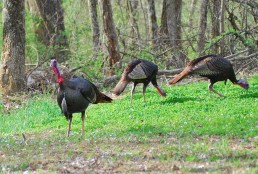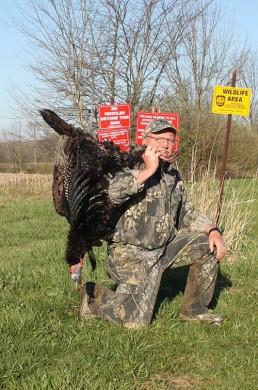Gobblers Favor Open Gas Line Habitats
SHARE THIS POST
If one fact holds true for spring turkey hunters, it’s the reality that success increases whenever we search for the best habitats. Eventually, we learn that turkeys are diverse and live within a variety of habitat configurations. Therefore, it seems logical that hunters should concentrate on landscapes that provide them with optimum hunting options.
But are there ideal locations to pursue gobblers?
Hunters can be thankful that the topography turkeys favor provides diversity with rugged to semi-hilly terrains. We can hunt landscape features that test us because of steep hills. Or, we find terrain that gradually contours to a more level topography. Turkeys can deal with a variety of habitats, and this is why hunters are forced to go where turkeys are most active. And one such location is where utility companies cut right through dense woodland structures, opening hunting freeways. I am absolutely certain that gas line roadways offer a variety of options for any spring turkey hunter. Although many are cut through private lands, there are thousands of miles of public acreage that permits hunters various opportunities for chances at outmaneuvering spring gobblers. Perhaps this is why my 2015 gobbler was a quick-tag.
The second morning of last year’s spring turkey season ended quickly. I selected the wood line cover bordering an old gas line because I had watched turkeys feeding along the gas line a week before legal season. Accessing the location I planned to hunt, I decided it was more likely approachable by parking 1/2 mile away—a struggling walk through rolling woods and crossing two step-across streams. I would also be sliding down a steep embankment before a careful walk up a wooded slope. The tom, or should I say toms, began gobbling before I was halfway to my preselected woods line cover. I soon found I had made the right choice.
I concealed myself within a cluster of underbrush foliage along the edge of the open gas line. As I was catching my breath, my excitement intensified when I heard three different toms gobbling. Although I didn’t hear hens, this wasn’t unusual, even when the hens and toms are roosted together. At least I knew there were gobblers still on roost—but not for long.
Wasting no time, they pitched down to the ground. I momentarily closed my eyes and listened to their vocals echoing across the landscape. They were intensely vocal, so I began with aggressive calling. They hammered back, zigzagging back and forth in front of me. Unfortunately, they hung up and refused to show themselves. I was certain they wanted me to go to them. Cautiously, I clucked softly a few times, stopped calling and waited.
One “mouthy” tom finally became interested in leaving the density of woodland cover on the opposite side of the gas line, but not before stopping, standing motionless and studying the openness of the gas line for several minutes. Now was not the time to overcall.
So, how did I work him?
When he wasn’t looking in my direction, I raked ground-level leaves with my left hand. He gobbled; I waited several minutes, raked leaves again then I purred. He gobbled hard and began his cautious sneak-walk toward me.
Are you enjoying this post?
You can be among the first to get the latest info on where to go, what to use and how to use it!
He seemed to use every tree in his favor, stopping frequently behind several trees as if to use each one as a body-block. There was no doubt patience enabled me to shoot this gobbler after he eventually peaked his head and neck outward from behind a huge oak tree at the edge of the open gas line.
Open and semi-open landscapes are crucial to mating gobblers. Gas lines are usually created by removing woodland structures; select cuts are made that extend mile-after-mile of open landscape roadways. This timber removal produces openings where wildlife can feed on new-growth foliage. These terrains are vital to nesting hens and gobblers strutting exposure. Plus, they provide concealment cover nearby for quick escapes. Toms can also see long distances for predators. Therefore, these public land gas lines can be anyone’s dream hunting location.
Obviously, open landscape appeals to mating gobblers because the features provide gobblers high-visibility strutting so hens to see them. They can also spot predators throughout a breeding session. It is believed that toms prefer some degree of comfort when breeding hens. An open, grassy landscape provides this security. However, because turkeys are always cautious and careful to avoid predators, concealing woodland cover nearby on either side of a gas line pathway gives toms and edge.
Habitats are the “key” to locating and hunting turkeys. High-top gas lines enable gobblers to transmit their gobbles for long distances. Toms can strut and gobble for vocal and visual exposure. However, they will remain vigilant and constantly study the terrain for potential threats from intruders.
Wild turkeys are very adaptable and can survive within numerous types of habitats. And habitat quality improves their survival. Turkeys require diverse landscape features that provide food sources, roost trees and open areas for viewing their surroundings. The public lands can add extra hunting pressure, as one must be on guard every second for other hunters. Public lands occasionally have “drivable” access roads—to a point. However, if you find access roads that are heavily traveled, avoid these more obvious roadways.
Why do gas lines appeal to hunters? What are some advantages?
Sideline woodland cover provides exceptional concealment from approaching or circling turkeys. Hunters are comfortably able to hide and sneak along open gas lines. There are shadows-galore for hiding. It’s easy to quickly use the deceptive cover of foliage, trees and underbrush. And, hunters can view the open landscape for any available gobbler, any time. Natural food sources are everywhere, with fresh grasses and umpteen varieties of insects. Nearby woodland cover, with greening foliage and leftover mast, is also favorable for turkeys. Yes, there are many positive reasons to hunt gas lines.
The unique diversity of gas line landscapes will provide hunters with many opportunities. Scout gas lines in search of your next gobbler and you will quickly learn to focus on gas line habitats. Eventually, you will love gas-line gobblers, too.
MWO
SHARE THIS POST
You may also like...
Did you enjoy this post?
You can be among the first to get the latest info on where to go, what to use and how to use it!
Bob Grewell
Bob “Greenie” Grewell has written about and photographed the outdoors for 40 years. He’s travelled throughout the U.S., Canada, the Arctic Circle, as well as Germany and Denmark. He has written a book on hunting dogs and contributed articles and photography to others. He currently focuses on deer and turkey articles, and wildlife photography.


